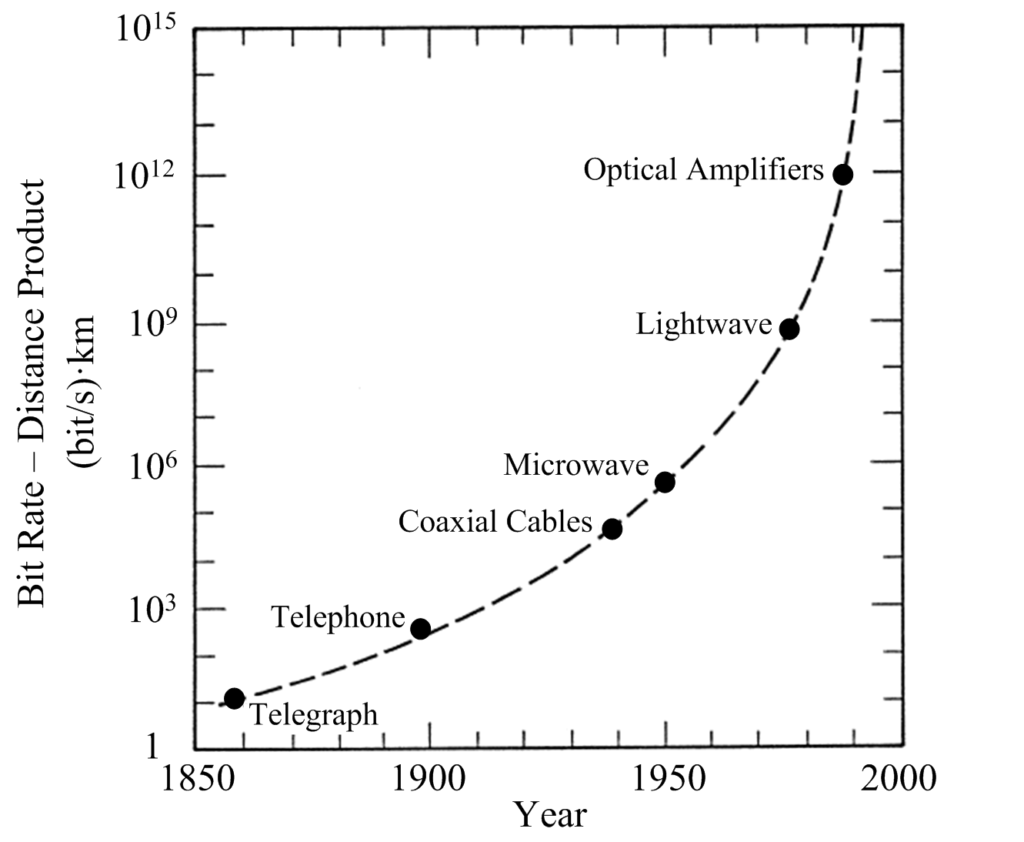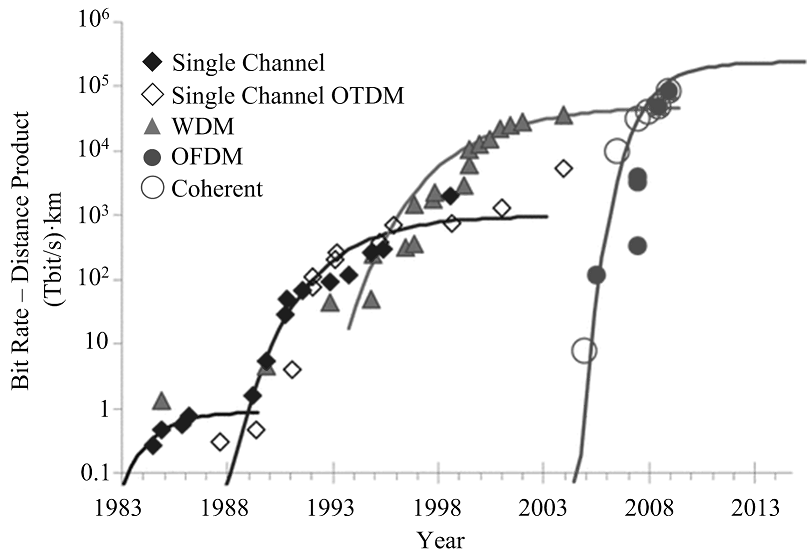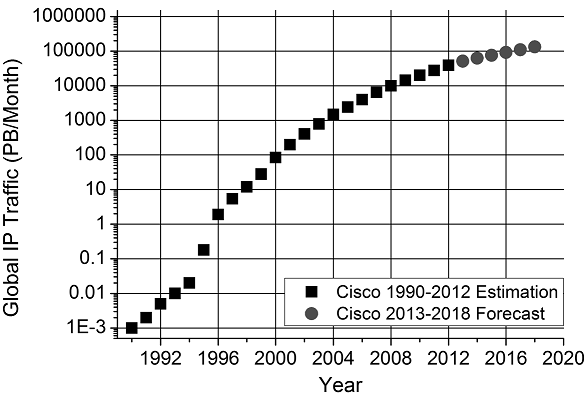This article shows the relevance of optical communications emphasizing how the introduction of optical devices marked an inflexion point in the performance of guided data links. The development of electro-optical technology allowed to increase simultaneously the distance and capactiy of communications systems. In practice, optical communications have enabled the ever-increasing worldwide data traffic.
The table of contents is provided below:
1. Bit Rate – Distance Product
The Bit Rate – Distance product is a figure of merit of any digital communication link. It is equal to B∙L where B is the bit rate and L is the repeater spacing. Next figure illustrates the evolution of this value in deployed links along the period extending from 1850 to 2000 [1]. It can be observed that the value increased exponentially through the introduction of emerging technologies. During the last decades, optical devices have made possible the latest revolutions in the field.

1.1 Early Developments
In the 1950s it was theoretically known that the B∙L product could be increased by several orders of magnitude employing optical waves as carriers [1]. However, suitable sources of lightwaves and a transmission medium were not available. In 1960, the demonstration of the first functional laser solved the first problem, and, in 1966, optical fibre was proposed as the best choice for guiding light. Those were the first steps that led to the development of modern optical communications.
The subsequent breakthroughs proved the feasibility of optical systems. In 1970, semiconductor lasers operating continuously at room temperature were demonstrated. Simultaneously, fibre losses were reduced below 20 dB/km at wavelengths ≈1μm. The first commercial optical links were finally available in 1980, and transmitted 45 Mbit/s at 0.8 μm with a repeater spacing of up to 10 km. The next efforts focused on transmitting at wavelengths ≈1.3 μm, where optical fibre presented losses below 1 dB/km and minimum dispersion. In 1981, such systems were able to transmit 2 Gbit/s over 44 km and, in 1987, similar schemes became commercially available.
The subsequent steps attempted to use wavelengths around 1.55 μm, where fibre losses are lower, namely 0.2 dB/km. The introduction of these systems was delayed because fibre dispersion at 1.55 μm was higher. Two compatible solutions were proposed: dispersion shifted fibres and lasers capable of emitting only one longitudinal mode. In 1985, laboratory experiments showed rates of up to 4 Gbit/s over 100 km of fibre, but this technology did not become commercially available until 1990.
1.2 The Advent of Optical Amplifiers and WDM
The next revolution occurred during the 1990s with the advent of optical amplifiers, as it can be observed in previous figure. These devices avoid the necessity of electronic repeaters. In 1991, an experiment demonstrated the transmission of 5 Gbit/s over 14.300 km. By 1995, these systems became commercially available and were implemented in transoceanic links.
Simultaneously, a technique defined as Wavelength Division Multiplexing (WDM) substantially multiplied the achievable capacity. WDM consists of transmitting a number of optical channels in the same optical fibre, each one carried by a different wavelength. Combining these breakthroughs, optical amplifiers and WDM, the B∙L products increased drastically. In 2001, 300 optical channels operating individually at 11.6 Gbit/s were transmitted over 7380 km, resulting in a B∙L product of more than 25000 (Tb/s)∙km.
1.3 Modern Developments
During the last 20 years, efforts have been focused on the implementation of spectrally efficient modulation formats that can increase the data rate per optical channel. Firstly, traditional modulation schemes were employed using multilevel configurations. Later, more sophisticated modulations, like Orthogonal Frequency Division Multiplexing (OFDM), were proposed. Finally, coherent systems were implemented to reach longer transmission distances.
Coherent transmission modulates the phase of the optical carrier reducing the average power of the signal [1]. Lower sensitivities and longer transmission distances are achieved at the expense of requiring complex and expensive receivers. Coherent schemes were well known since the 1980s, but they have only become a requisite to increase the B∙L product in the last decades, as it can be observed in next figure.

The image shows the evolution of the B∙L product obtained in optical communication experiments since 1983, classifying them according to the implemented technique: single wavelength, single wavelength with Optical Time Division Multiplexing (OTDM), WDM, OFDM and coherent detection. As an example, in 2009, a WDM coherent OFDM experiment achieved a B∙L product of ≈85000 (Tb/s)∙km. Currently, the B∙L product can be increased beyond 106 (Tbit/s)∙km by using multicore fibres.
2. Worldwide Data Traffic
The introduction of the Internet and its growth during the last decades brought about the necessity of implementing high speed data networks. To satisfy the ever-increasing demand of capacity, multidisciplinary advances were required in many technical fields like materials, electronics and communications. However, as explained above, lightwave transmission was and continues to be the only technology that can satisfy the demand of data traffic.

An estimation of the worldwide Internet Protocol (IP) data traffic since 1990 is illustrated above, taken from the Cisco´s Virtual Networking Index. During the 1990s Internet access popularised and IP data traffic at least doubled every year. More recently, modern and demanding services, like on-demand High Definition Television (HDTV), are increasing its popularity. World habits are changing towards a situation in which every device can potentially be connected to the Internet. Consequently, the most recent forecasts claim that the increase of IP data traffic per year is around 23%. Although this trend is less pronounced than in the past, some studies have concluded that, currently, the increment of data traffic tends to exceed the capacity of fibre communication systems. While optical communications technology matures, it becomes more difficult to increase the B∙L product, in line with the figure in section 1.3 above.
3. Conclusions
Due to the relevance of optical communciations, it can be concluded that the telecommunications industry is facing important and significant challenges. Research and development of optical technologies is of vital importance to find functional solutions.
It should be noted that data traffic must be processed at several stages giving rise to different types of optical networks. At every level, the optimal optical transceivers are in reality determined by different parameters like cost, power consumption and/or latency. For example, in an expensive transoceanic link, the priority is to increase the B∙L product at practically any cost. On the contrary, in a high performance data centre where multiple interfaces are necessary, low power consumption and latency are essential.
Bibliography
[1] Fiber-Optic Communication Systems, Govind P. Agrawal
Subscription
If you liked this contribution, feel free to subscribe to our newsletter:
